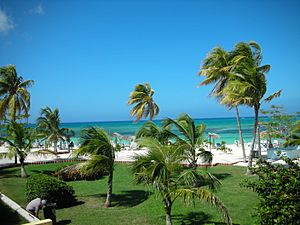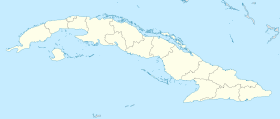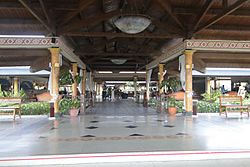Guardalavaca facts for kids
Quick facts for kids
Guardalavaca
|
|
|---|---|
|
Village
|
|

Beach at Guardalavaca
|
|
| Country | |
| Province | Holguín |
| Municipality | Banes |
| Elevation | 5 m (16 ft) |
| Time zone | UTC-5 (EST) |
| Area code(s) | +53-24 |
Guardalavaca is a lovely town in the Holguín Province of Cuba. It's a very popular place for tourists because of its beautiful white sandy beaches and warm, clear waters. The main Guardalavaca beach is protected by a big coral reef, which makes it a safe and fun place to swim. Both local Cubans and visitors from all over the world enjoy this beach.
Most people who work at the big hotels here travel daily from nearby cities like Holguin, Banes, and Rafael Freyre. Only a few people live right in Guardalavaca because the resort area is quite small.
Between Guardalavaca and Playa Esmeralda, you can find dry tropical forests. These forests are home to special Cuban birds, like the tiny Cuban emerald hummingbird. You might also spot many endemic Cuban knight anole lizards in these areas.
There's a daily flea market in Guardalavaca where you can find cool handmade Cuban souvenirs. Tourists staying at beaches further away, like Playa Esmeralda and Playa Pesquero, often come here for a visit. Another fun place to explore is the Taino museum and a museum village located between Guardalavaca and Banes. You can also visit the wildlife trail at Bahia de Naranjo. At Bahia de Naranjo, you can even go swimming with dolphins and visit a small zoo.
Frank Pais Airport is about an hour's drive south of Guardalavaca. This airport made it easy for tourists to visit, which helped the area become a popular beach-tourism spot. Many people who go on ecotourism and Wildlife tourism trips to the Baracoa Tropical Rainforest often stay in the large hotels around Guardalavaca because it's so close to the airport.
Contents
Exploring Guardalavaca's Location and Beaches
Guardalavaca is located on the northern coast of Cuba. It sits right next to Bahia de Naranjo, which means "Orange Bay." This area is part of the Banes municipality.
Beautiful Beaches to Discover
Besides the main Guardalavaca Beach, there are several smaller beaches to the west and east. Some beaches west of Guardalavaca have also been developed for visitors. However, there aren't many homes for local people in these areas, and not much development outside of the hotels.
These beaches include three main resort areas:
- About five kilometers (three miles) to the west, you'll find Playa Esmeralda. There are also smaller beaches within the Bahia de Naranjo nature reserve.
- Ten kilometers (six miles) to the west are Playa Yuraguanal and Playa Pesquero.
All these beaches have soft coral sand. They are also protected by coral reefs, making the waters calm and perfect for swimming. Each of these beaches features large all-inclusive hotels for tourists.
The Story Behind Guardalavaca's Name
The name "Guardalavaca" is interesting because it literally means "guard the cow" in Spanish. There are a couple of stories about how the town got this unusual name.
Pirates, Ships, and Cows
One story says that "Guardalavaca" might have originally been "Guardalabarca," which means "guard the ship." Long ago, this area was often attacked by sea pirates. Bahía de Naranjo, near Guardalavaca, is a hidden, shallow bay connected to the open sea by a narrow opening. This made it a perfect safe spot to hide and protect ships from pirates.
Another story suggests the name came from pirates who were trying to steal cattle grazing in the area. When pirates were spotted, local farmers would shout, "Guarda la vaca!" meaning "Guard the cow!" to warn everyone.
The Cuban government has tried a few times to change the name because they think "Guard the Cow" isn't very appealing for a tourist spot. But so far, the original name has stuck!
See also
 In Spanish: Guardalavaca para niños
In Spanish: Guardalavaca para niños



